A Four-Year Video Monitoring Analysis of the Posidonia oceanica Banquette Dynamic: A Case Study from an Urban Microtidal Mediterranean Beach (Poetto Beach, Southern Sardinia, Italy)
Abstract
:1. Introduction
2. Materials and Methods
2.1. Geographical Settings, Wave Climate, and Hydrodynamics of the Study Area
2.2. Video Monitoring System Settings and Wave Energy Flux Computation
3. Results
3.1. First Period, from the 20th of October 2016 to the 20th of June 2017
3.2. Second Period, from the 18th of October 2018 to the 22nd of January 2019
3.3. Third Period, from the 30th of November 2019 to the 20th of June 2020
3.4. Statistical Analysis
4. Discussion
5. Conclusions
Author Contributions
Funding
Data Availability Statement
Acknowledgments
Conflicts of Interest
References
- Duarte, C.M. Seagrass depth limits. Aquat. Bot. 1991, 40, 363–377. [Google Scholar] [CrossRef]
- Duarte, C.M. How can beaches be managed with respect to seagrass litter? In European Seagrasses: An Introduction to Monitoring and Management; Borum, J., Duarte, C.M., Krause-Jansen, D., Greeve, T.M., Eds.; The M&MS Project Publisher: Copenhagen, Denmark, 2004; pp. 83–84. ISBN 87-89143-21-3. [Google Scholar]
- Romero, J.; Pergent, G.; Pergent-Martini, C.; Mateo, M.-A.; Regnier, C. The Detritic Compartment in a Posidonia oceanica Meadow: Litter Features, Decomposition Rates, and Mineral Stocks. Mar. Ecol. 1992, 13, 69–83. [Google Scholar] [CrossRef]
- Pergent, G.; Pergent-Martini, C.; Boudouresque, C. Utilisation de l’herbier à Posidonia oceanica comme indicateur biologique de la qualité du milieu littoral en Méditerranée: État des connaissances. Mésogée 1995, 54, 3–27. [Google Scholar]
- Gobert, S.; Cambridge, M.; Velimirov, B.; Pergent, G.; Lepoint, G.; Bouquegneau, J.-M.; Dauby, P.; Pergent-Martini, C.; Walker, D.; Larkum, A.; et al. Biology of Posidonia. In Seagrasses: Biology, Ecology and Conservation; Springer: Dordrecht, The Netherlands, 2006; pp. 387–408. [Google Scholar] [CrossRef]
- Vacchi, M.; Montefalcone, M.; Bianchi, C.N.; Morri, C.; Ferrari, M. Hydrodynamic constraints to the seaward development of Posidonia oceanica meadows. Estuar. Coast. Shelf Sci. 2012, 97, 58–65. [Google Scholar] [CrossRef]
- Vacchi, M.; De Falco, G.; Simeone, S.; Montefalcone, M.; Morri, C.; Ferrari, M.; Bianchi, C.N. Biogeomorphology of the Mediterranean Posidonia oceanica seagrass meadows. Earth Surf. Process. Landf. 2017, 42, 42–54. [Google Scholar] [CrossRef]
- Borum, J.; Duarte, C.M.; Krause-Jensen, D.; Greve, T.M. (Eds.) European Seagrasses: An Introduction to Monitoring and Management; The M&MS Project, S. l.: Copenhagen, Denmark, 2004; Available online: http://www.seagrasses.org (accessed on 12 September 2023).
- Council Directive 92/43/EEC of 21 May 1992 on the Conservation of Natural Habitats and of Wild Fauna and Flora—Consolidated Version 01/01/2007 (EU Habitats Directive). Available online: https://eunis.eea.europa.eu/habitats/10004 (accessed on 24 September 2023).
- Calizza, E.; Costantini, M.L.; Carlino, P.; Bentivoglio, F.; Orlandi, L.; Rossi, L. Posidonia oceanica habitat loss and changes in litter-associated biodiversity organization: A stable isotope-based preliminary study. Estuar. Coast. Shelf Sci. 2013, 135, 137–145. [Google Scholar] [CrossRef]
- Duarte, C.M.; Chiscano, C.L. Seagrass biomass and production: A reassessment. Aquat. Bot. 1999, 65, 159–174. [Google Scholar] [CrossRef]
- Boudouresque, C.-F.; Bernard, G.; Bonhomme, P.; Charbonnel, E.; Diviacco, G.; Meinesz, A.; Pergent, G.; Pergent-Martini, C.; Ruitton, S.; Tunesi, L. Protection and Conservation of Posidonia oceanica Meadows; RAMOGE and RAC/SPA: 2012. ISBN N° 2-905540-31-1. Available online: https://www.rac-spa.org/sites/default/files/doc_vegetation/ramoge_en.pdf (accessed on 24 August 2023).
- Sánchez-González, J.F.; Sánchez-Rojas, V.; Memos, C.D. Wave attenuation due to Posidonia oceanica meadows. J. Hydraul. Res. 2011, 49, 503–514. [Google Scholar] [CrossRef]
- Elginoz, N.; Kabdasli, M.S.; Tanik, A. Effects of Posidonia oceanica Seagrass Meadows on Storm Waves. J. Coast. Res. 2011, 64, 373–377. [Google Scholar]
- Infantes, E.; Orfila, A.; Simarro, G.; Terrados, J.; Luhar, M.; Nepf, H. Effect of a seagrass (Posidonia oceanica) meadow on wave propagation. Mar. Ecol. Prog. Ser. 2012, 456, 63–72. [Google Scholar] [CrossRef]
- Koftis, T.; Prinos, P.; Stratigaki, V. Wave damping over artificial Posidonia oceanica meadow: A large-scale experimental study. Coast. Eng. 2013, 73, 71–83. [Google Scholar] [CrossRef]
- DeMuro, S.; Ibba, A.; Simeone, S.; Buosi, C.; Brambilla, W. An integrated sea-land approach for mapping geomorphological and sedimentological features in an urban microtidal wave-dominated beach: A case study from S Sardinia, western Mediterranean. J. Maps 2017, 13, 822–835. [Google Scholar] [CrossRef]
- Montefalcone, M.; Vacchi, M.; Archetti, R.; Ardizzone, G.; Astruch, P.; Bianchi, C.N.; Calvo, S.; Criscoli, A.; Fernández-Torquemada, Y.; Luzzu, F.; et al. Geospatial modelling and map analysis allowed measuring regression of the upper limit of Posidonia oceanica seagrass meadows under human pressure. Estuar. Coast. Shelf Sci. 2019, 217, 148–157. [Google Scholar] [CrossRef]
- De Muro, S.; Buosi, C.; Biondo, M.; Ibba, A.; Ruju, A.; Trogu, D.; Porta, M. Ecogeomorphology and vulnerability in a Mediterranean ria-type coast (La Maddalena Archipelago, NE Sardinia, western Mediterranean). J. Maps 2021, 17, 690–704. [Google Scholar] [CrossRef]
- Boudouresque, C.; Meinesz, A. Découverte de l’herbier de Posidonies. Cah. Parc Natl. Port-Cros 1982, 4, 1–79. [Google Scholar]
- De Falco, G.; Simeone, S.; Baroli, M. Management of Beach-Cast Posidonia oceanica Seagrass on the Island of Sardinia (Italy, Western Mediterranean). J. Coast. Res. 2008, 24, 69–75. [Google Scholar] [CrossRef]
- Simeone, S.; De Falco, G. Morphology and composition of beach-cast Posidonia oceanica litter on beaches with different exposures. Geomorphology 2012, 151–152, 224–233. [Google Scholar] [CrossRef]
- Short, A.D. Handbook of Beach and Shoreface Morphodynamics; John Wiley: Chichester, UK, 1999; ISBN 0-471-96570-7. [Google Scholar]
- Simeone, S.; De Muro, S.; De Falco, G. Seagrass berm deposition on a Mediterranean embayed beach. Estuar. Coast. Shelf Sci. 2013, 135, 171–181. [Google Scholar] [CrossRef]
- Astudillo, C.; Gracia, V.; Sierra, J.P.; Cáceres, I.; Sánchez-Arcilla, A. Posidonia beach-cast and banquette: Evaluation of sediment trapping and characterisation for coastal protection. In Coastal Sediments 2023; World Scientific: New Orleans, LA, USA, 2023; pp. 2265–2277. [Google Scholar] [CrossRef]
- ISPRA. Formazione e Gestione delle Banquettes di Posidonia oceanica Sugli Arenili; Manuali e Linee Guida 55/2010; ISPRA: Ispra, Italy, 2010; pp. 2265–2277. ISBN 978-88-448-0426-8. [Google Scholar]
- Gómez-Pujol, L.; Orfila, A.; Álvarez-Ellacuría, A.; Terrados, J.; Tintoré, J. Posidonia oceanica beach-cast litter in Mediterranean beaches: A coastal videomonitoring study. J. Coast. Res. 2013, 165, 1768–1773. [Google Scholar] [CrossRef]
- Trogu, D.; Buosi, C.; Ruju, A.; Porta, M.; Ibba, A.; De Muro, S. What Happens to a Mediterranean Microtidal Wave-dominated Beach during Significant Storm Events? The Morphological Response of a Natural Sardinian Beach (Western Mediterranean). J. Coast. Res. 2020, 95, 695. [Google Scholar] [CrossRef]
- Otero, M.M.; Simeone, S.; Aljinovic, B.; Salomidi, M.; Mossone, P.; Giunta Fornasin, M.E.; Gerakaris, V.; Guala, I.; Milano, P.; Heurtefeux, H.; et al. Governance and Management of Posidonia Beach-Dune System; POSBEMED Interreg Med Project; 2018; 66p + Annexes. Available online: https://www.iucn.org/our-work/projects/governance-and-management-posidonia-beach-dune-systems-across-mediterranean (accessed on 17 July 2023).
- Simeone, S.; Palombo, A.G.L.; Antognarelli, F.; Brambilla, W.; Conforti, A.; De Falco, G. Sediment Budget Implications from Posidonia oceanica Banquette Removal in a Starved Beach System. Water 2022, 14, 2411. [Google Scholar] [CrossRef]
- Simeone, S.; De Falco, G. Posidonia oceanica banquette removal: Sedimentological, geomorphological and ecological implications. J. Coast. Res. 2013, 65, 1045–1050. [Google Scholar]
- Astier, J.-M.; Boudouresque, C.; Pergent, G.; Pergent-Martini, C. Non-removal of the Posidonia oceanica “banquette” on a beach very popular with tourists: Lessons from Tunisia. Sci. Rep. Port-Cros Natl. 2020, 34, 15–21. [Google Scholar]
- Ruju, A.; Buosi, C.; Coco, G.; Porta, M.; Trogu, D.; Ibba, A.; De Muro, S. Ecosystem services of reed and seagrass debris on a urban Mediterranean beach (Poetto, Italy). Estuar. Coast. Shelf Sci. 2022, 271, 107862. [Google Scholar] [CrossRef]
- Lolli, I. The protection of Posidonia oceanica (L.) Delile and the management of its beach-cast leaves. Italian juridical framework. In Proceedings of the Ninth International Symposium “Monitoring of Mediterranean Coastal Areas: Problems and Measurement Techniques”, Livorno, Italy, 14–16 June 2022; Bonora, L., Carboni, D., De Vincenzi, M., Matteucci, G., Eds.; Firenze University Press: Florence, Italy, 2022; pp. 700–718. [Google Scholar] [CrossRef]
- Vandarakis, D.; Kourliaftis, I.; Salomidi, M.; Gerakaris, V.; Issaris, Y.; Agaoglou, C.; Kapsimalis, V.; Panagiotopoulos, I. Geomorphological approaches to study Posidonia banquettes and their effects on the coastal front of Schin–as—Marathon National Park. In Proceedings of the Ninth International Symposium “Monitoring of Mediterranean Coastal Areas: Problems and Measurement Techniques”, Livorno, Italy, 14–16 June 2022; Bonora, L., Carboni, D., De Vincenzi, M., Matteucci, G., Eds.; Firenze University Press: Florence, Italy, 2022; pp. 93–103. [Google Scholar] [CrossRef]
- Tomasello, A.; Bosman, A.; Signa, G.; Rende, S.F.; Andolina, C.; Cilluffo, G.; Cassetti, F.P.; Mazzola, A.; Calvo, S.; Randazzo, G.; et al. 3D-Reconstruction of a Giant Posidonia oceanica Beach Wrack (Banquette): Sizing Biomass, Carbon and Nutrient Stocks by Combining Field Data with High-Resolution UAV Photogrammetry. Front. Mar. Sci. 2022, 9, 903138. [Google Scholar] [CrossRef]
- Astudillo, C.; Gracia, V.; Cáceres, I.; Sierra, J.P.; Sánchez-Arcilla, A. Beach profile changes induced by surrogate Posidonia Oceanica: Laboratory experiments. Coast. Eng. 2022, 175, 104144. [Google Scholar] [CrossRef]
- Sabato, G.; Scardino, G.; Kushabaha, A.; Chirivì, M.; Luparelli, A.; Scicchitano, G. Deep learning-based segmentation techniques for coastal monitoring and seagrass banquette detection. In Proceedings of the 2023 IEEE International Workshop on Metrology for the Sea, Learning to Measure Sea Health Parameters (MetroSea). La Valletta, Malta, 4–6 October 2023; pp. 524–527. [Google Scholar] [CrossRef]
- Provost, L.A.; Eisemann, E.R.; Anderson, C.P.; Waldron, M.C.B. Wrack placement to augment constructed dunes: A field investigation. Front. Built Environ. 2022, 8, 907608. [Google Scholar] [CrossRef]
- Paquier, A.-E.; Laigre, T.; Belon, R.; Balouin, Y.; Valentini, N.; Mugica, J. Video monitoring of Posidonia oceanica banquettes on pocket beaches, Northern Corsica. In Proceedings of the XVIèmes Journées, Le Havre, Presented at the Journées Nationales Génie Côtier—Génie Civil, Le Havre, France, 8–10 December 2020; Editions Paralia. pp. 675–682. Available online: http://www.paralia.fr (accessed on 30 June 2023). [CrossRef]
- Passarella, M.; Ruju, A.; Muro, S.D.; Coco, G. Horizontal Runup and Seagrass Beach Cast-litters: Modelling and Observations. J. Coast. Res. 2020, 95, 143–147. [Google Scholar] [CrossRef]
- Ruju, A.; Passarella, M.; Trogu, D.; Buosi, C.; Ibba, A.; De Muro, S. An Operational Wave System within the Monitoring Program of a Mediterranean Beach. J. Mar. Sci. Eng. 2019, 7, 32. [Google Scholar] [CrossRef]
- Scardino, G.; Scicchitano, G.; Chirivì, M.; Costa, P.J.M.; Luparelli, A.; Mastronuzzi, G. Convolutional Neural Network and Optical Flow for the Assessment of Wave and Tide Parameters from Video Analysis (LEUCOTEA): An Innovative Tool for Coastal Monitoring. Remote Sens. 2022, 14, 2994. [Google Scholar] [CrossRef]
- Pranzini, E. Il colore della sabbia: Percezione, caratterizzazione e compatibilità nel ripascimento artificiale delle spiagge. Studi Costieri 2008, 15, 89–108. [Google Scholar]
- Biondo, M.; Buosi, C.; Trogu, D.; Mansfield, H.; Vacchi, M.; Ibba, A.; Porta, M.; Ruju, A.; De Muro, S. Natural vs. Anthropic Influence on the Multidecadal Shoreline Changes of Mediterranean Urban Beaches: Lessons from the Gulf of Cagliari (Sardinia). Water 2020, 12, 3578. [Google Scholar] [CrossRef]
- Orrù, P.E.; Antonioli, F.; Lambeck, K.; Verrubbi, V. Holocene sea level change of the Cagliari. Quat. Nova 2004, 8, 193–212. [Google Scholar]
- Porta, M.; Buosi, C.; Trogu, D.; Ibba, A.; De Muro, S. An integrated sea-land approach for analyzing forms, processes, depos-its and the evolution of the urban coastal belt of Cagliari. J. Maps 2021, 17, 65–74. [Google Scholar] [CrossRef]
- Brambilla, W.; Van Rooijen, A.; Simeone, S.; Ibba, A.; DeMuro, S. Field Observations, Video Monitoring and Numerical Model-ing at Poetto Beach, Italy. J. Coast. Res. 2016, 75, 825–829. [Google Scholar] [CrossRef]
- Piscopia, R.; Franco, L.; Corsini, S.; Inghilesi, R. Atlante Delle Onde nei Mari Italiani—Italian Wave Atlas; Full Final Report a cura dell’APAT; Università di Roma Tre: Roma, Italy, 2004. [Google Scholar]
- Korres, G.; Ravdas, M.; Zacharioudaki, A.; Denaxa, D.; Sotiropoulou, M. Mediterranean Sea Waves Reanalysis (CMEMS Med-Waves, MedWAM3 System) (Version 1) Data Set; Copernicus Monitoring Environment Marine Service (CMEMS): 2021. Available online: https://data.marine.copernicus.eu/product/MEDSEA_MULTIYEAR_WAV_006_012/description (accessed on 20 May 2021).
- Hersbach, H.; Bell, B.; Berrisford, P.; Biavati, G.; Horányi, A.; Muñoz Sabater, J.; Nicolas, J.; Peubey, C.; Radu, R.; Rozum, I.; et al. ERA5 Hourly Data on Single Levels from 1940 to Present. Copernicus Climate Change Service (C3S) Climate Data Store (CDS). 2023. Available online: https://cds.climate.copernicus.eu/cdsapp#!/dataset/reanalysis-era5-single-levels?tab=overview (accessed on 20 September 2023).
- Brambilla, W. Caratterizzazione Morfodinamica Della Spiaggia del Poetto. Ph.D. Thesis, University of Cagliari, Cagliari, Italy, 2015. [Google Scholar]
- Passarella, M. On the Prediction of Swash Excursion and the Role of Seagrass Beach-Cast Litter: Modelling and Observations. Ph.D. Thesis, University of Cagliari, Cagliari, Italy, 2019. [Google Scholar]
- Sardegna Geoportale. Available online: https://www.sardegnageoportale.it/ (accessed on 1 March 2021).
- Liang, B.; Shao, Z.; Wu, G.; Shao, M.; Sun, J. New equations of wave energy assessment accounting for the water depth. Appl. Energy 2017, 188, 130–139. [Google Scholar] [CrossRef]

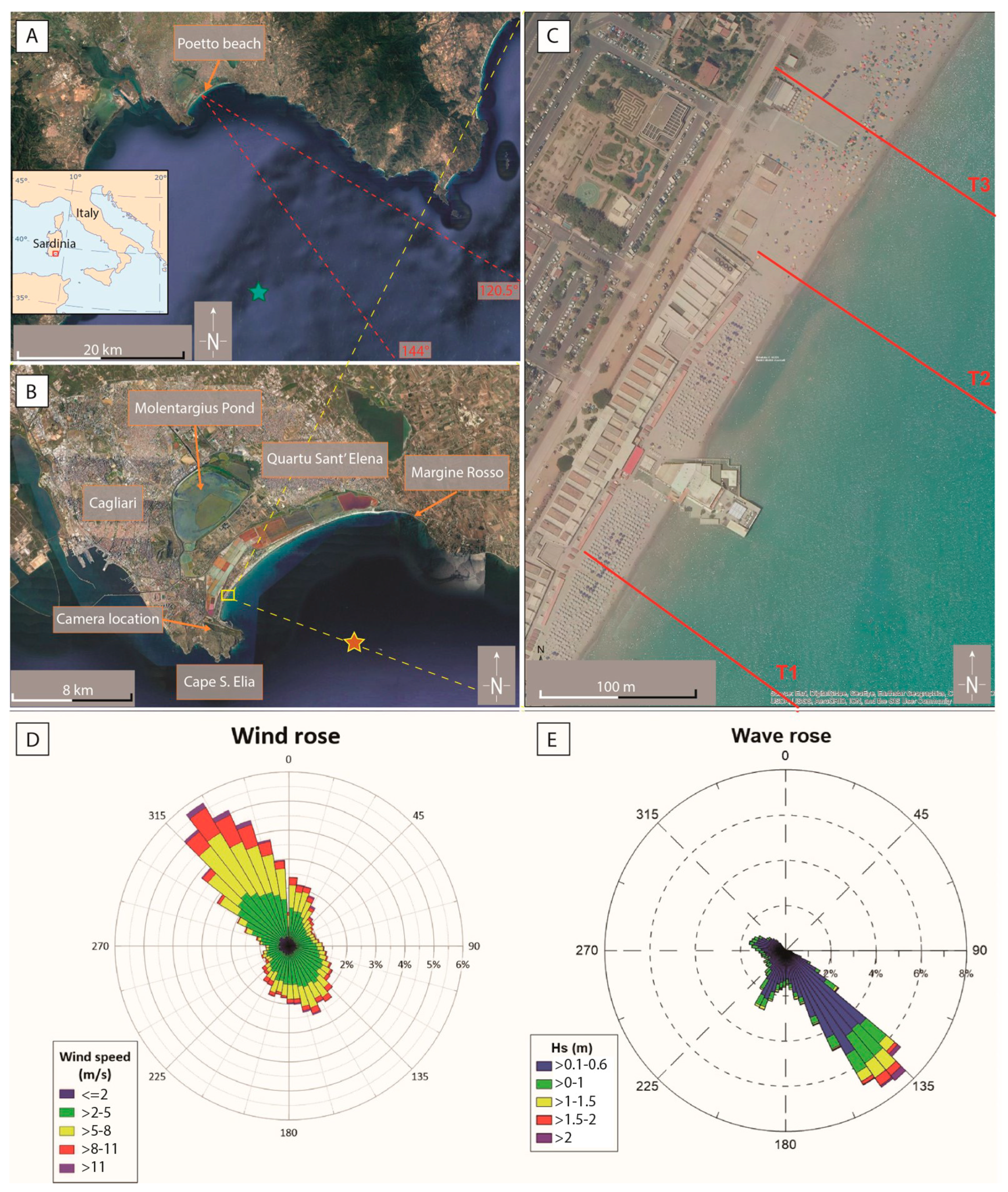
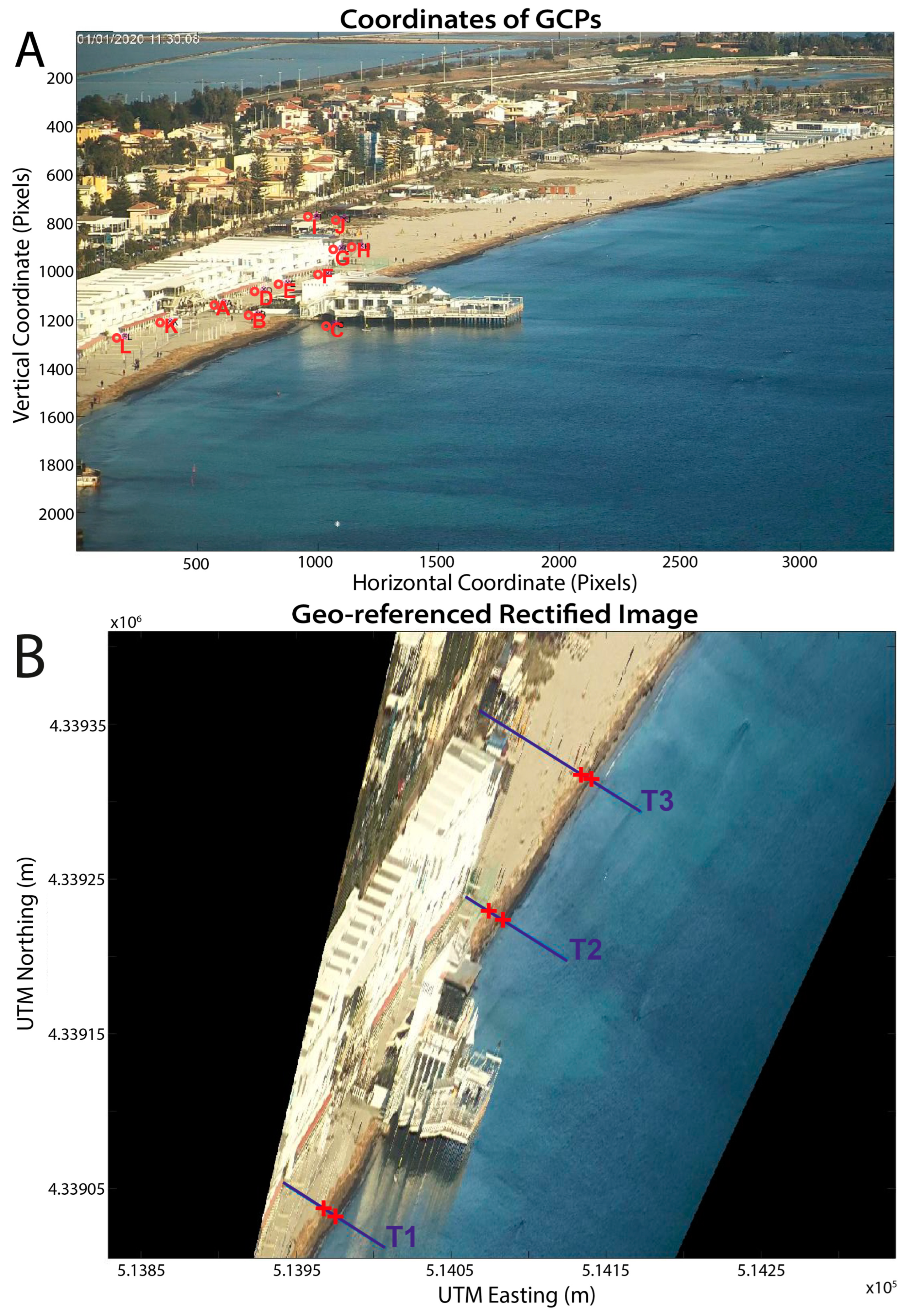
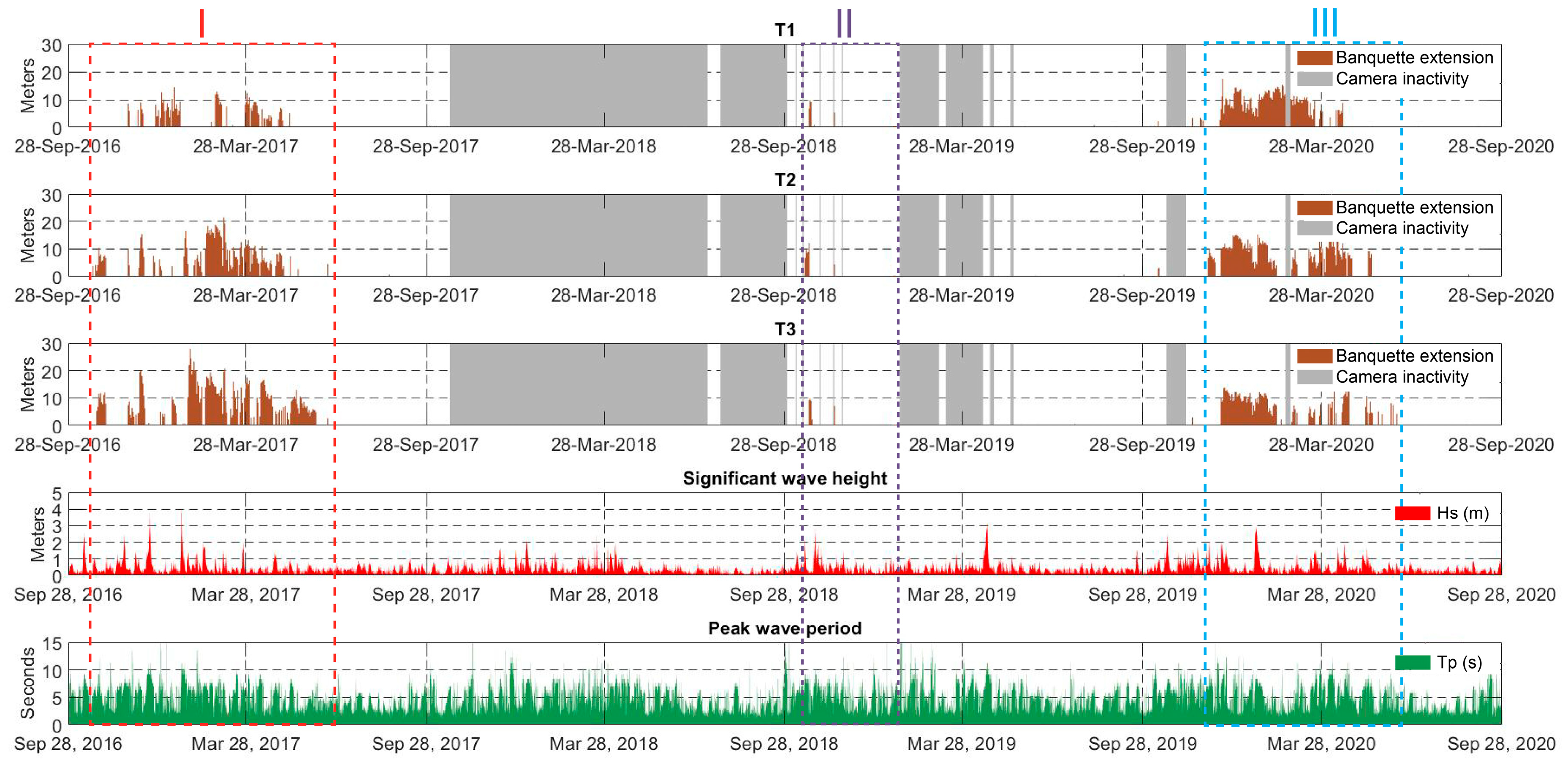

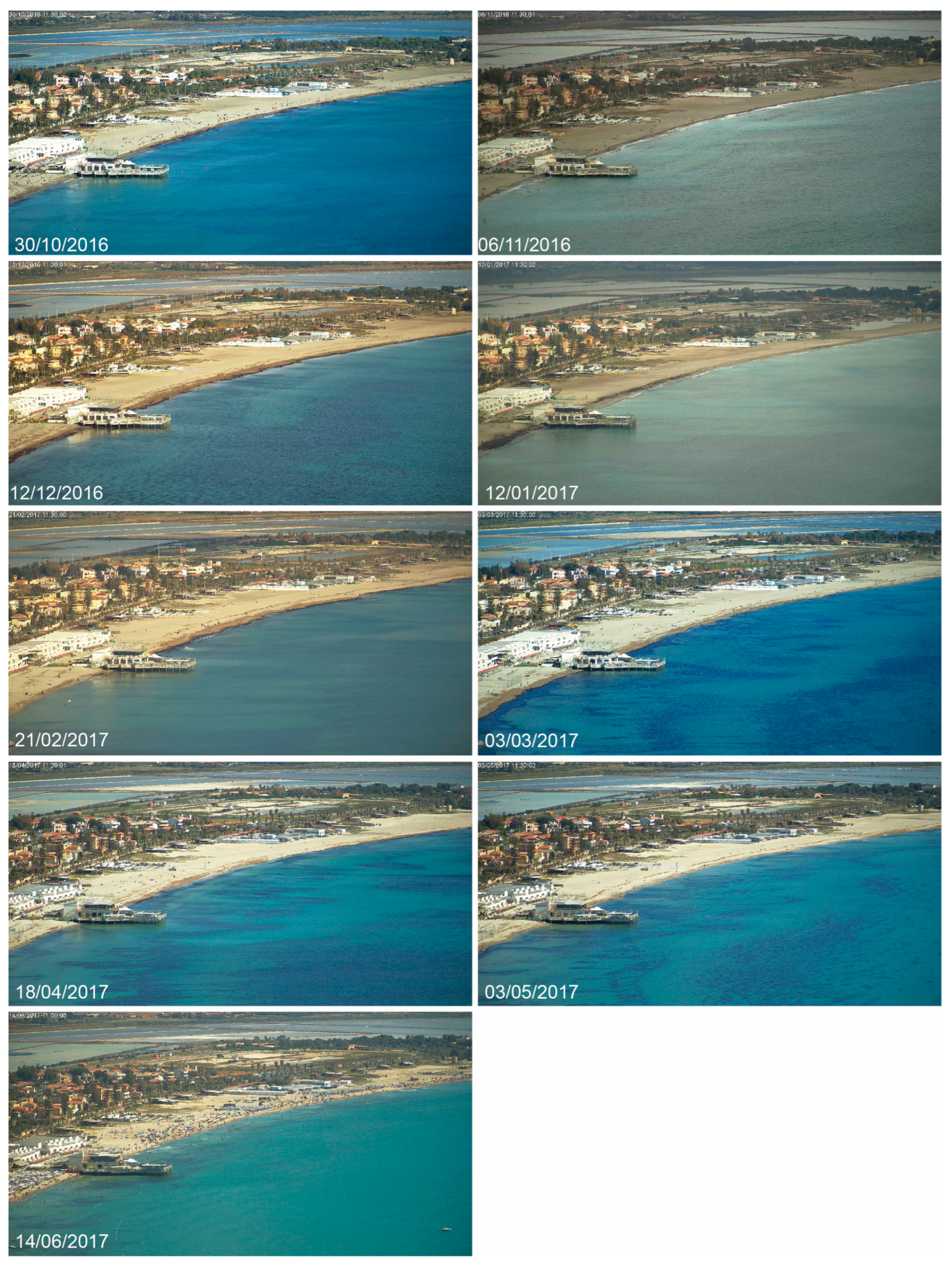
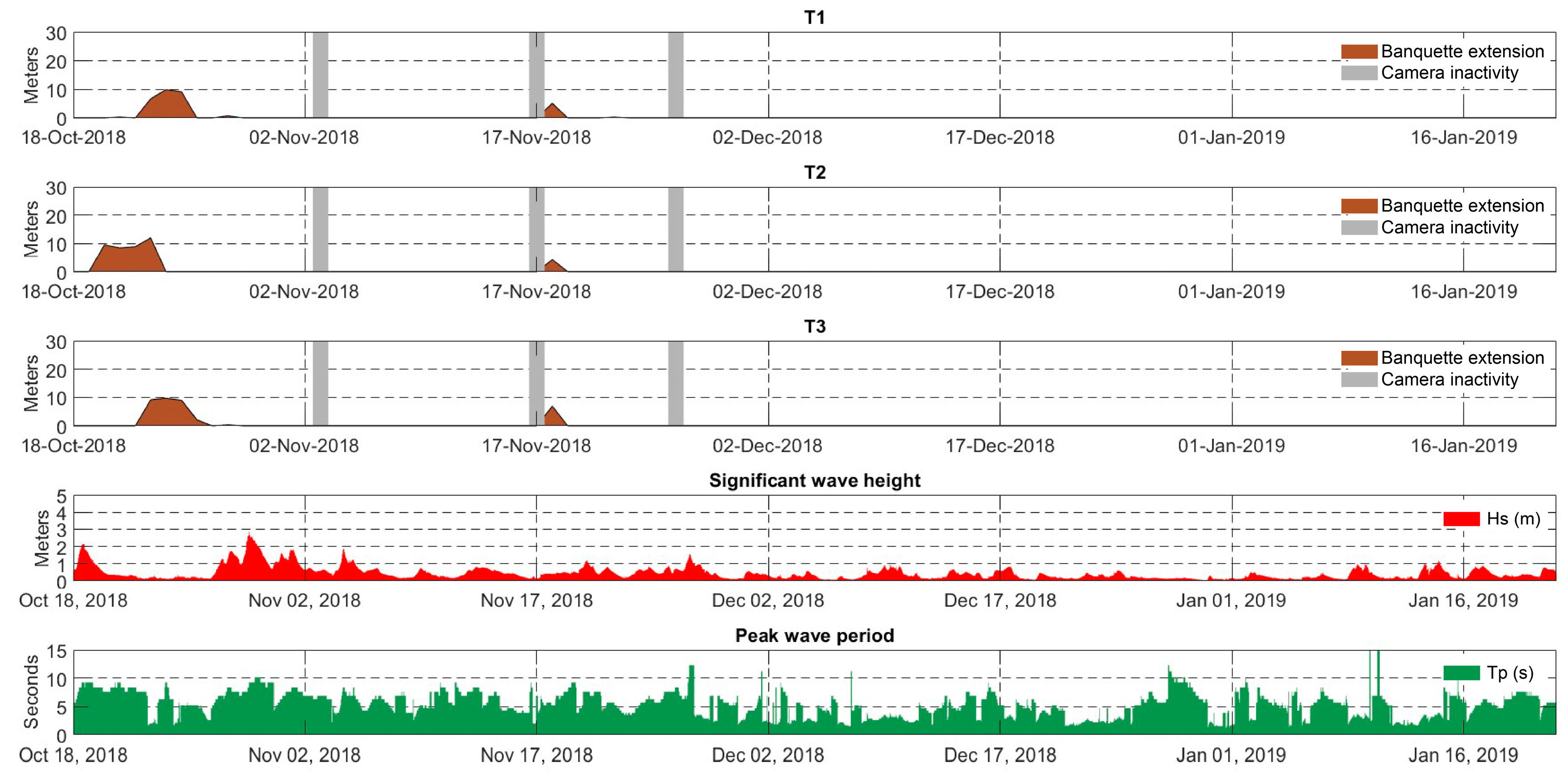

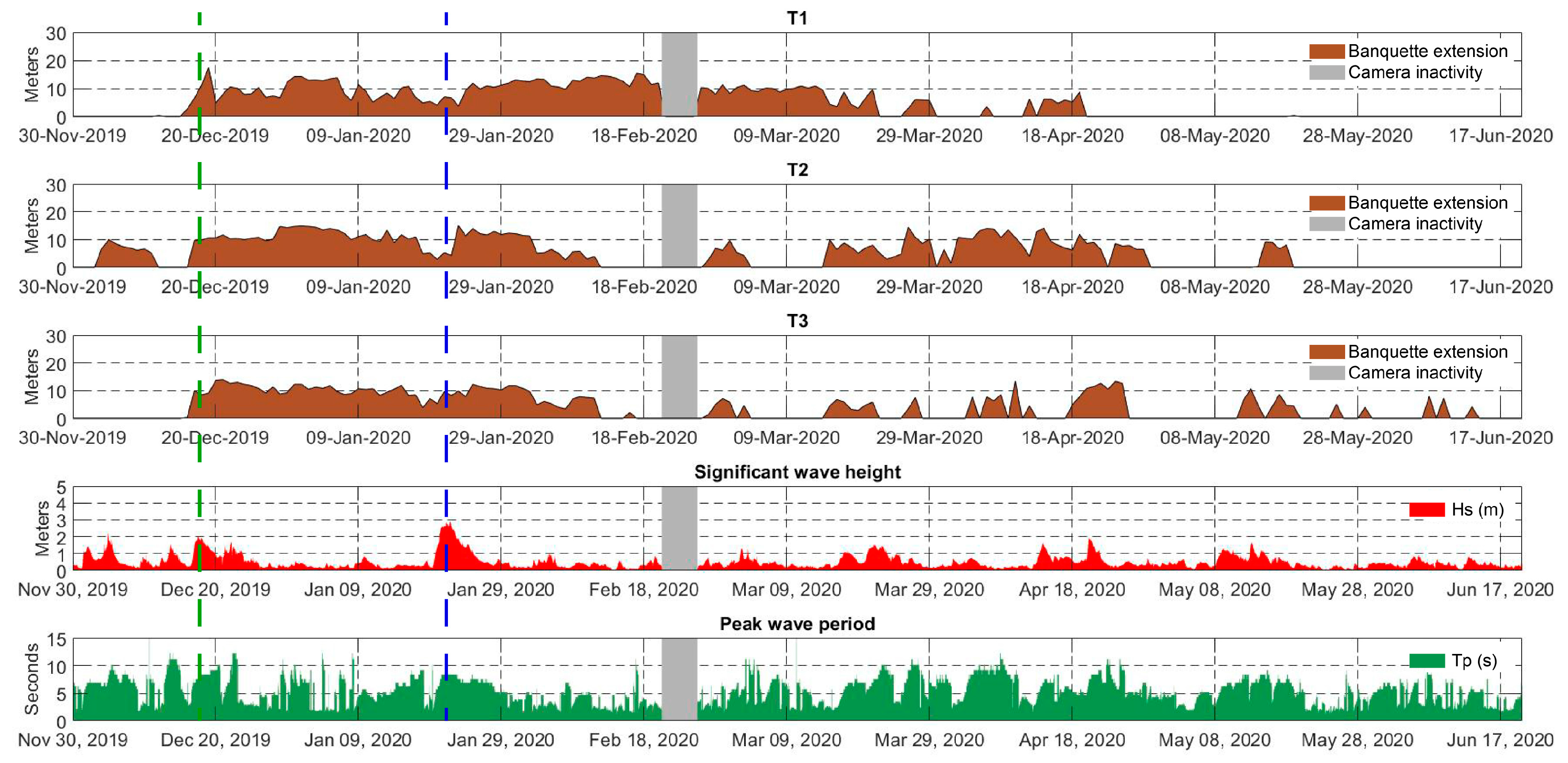
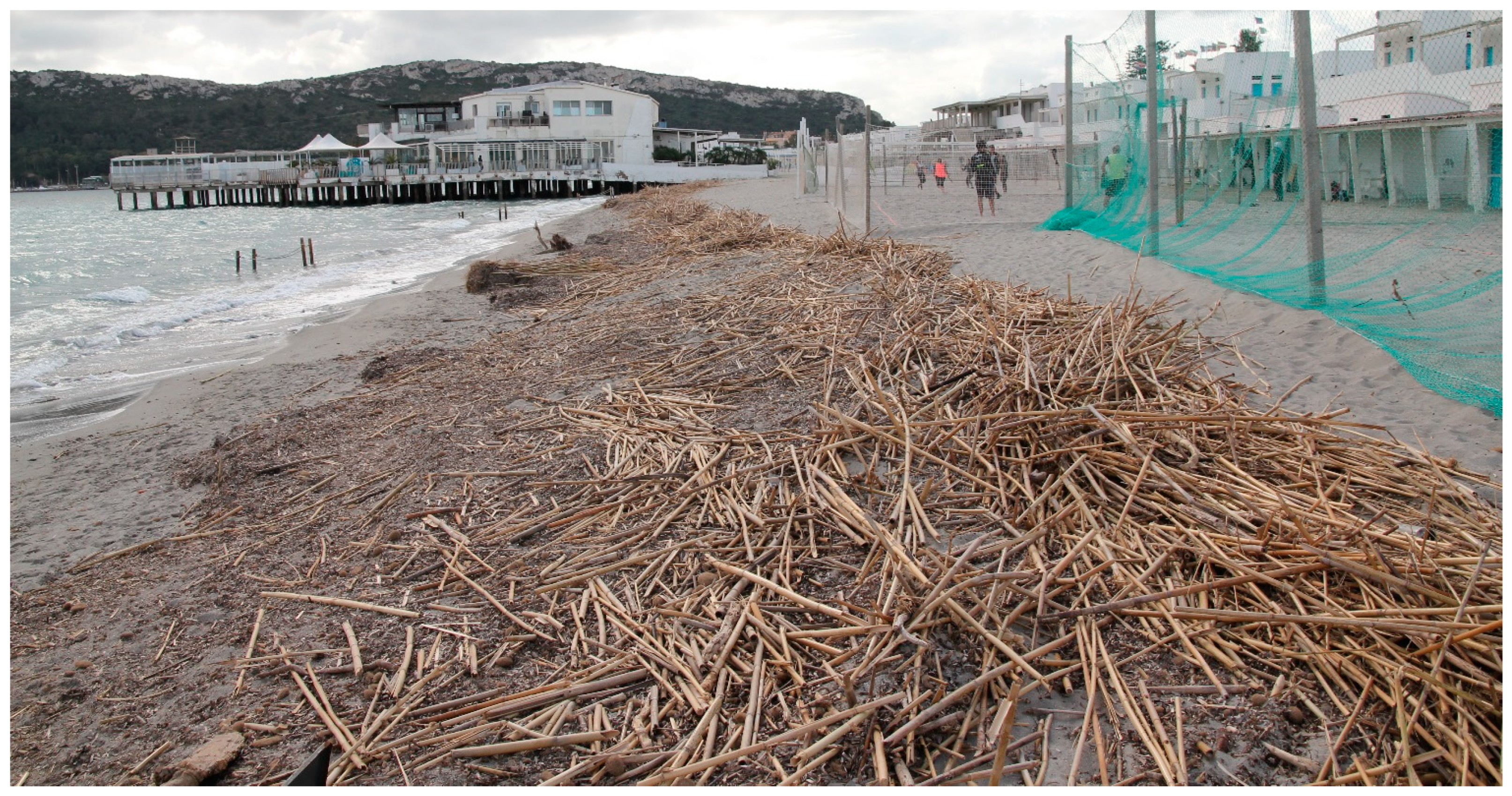

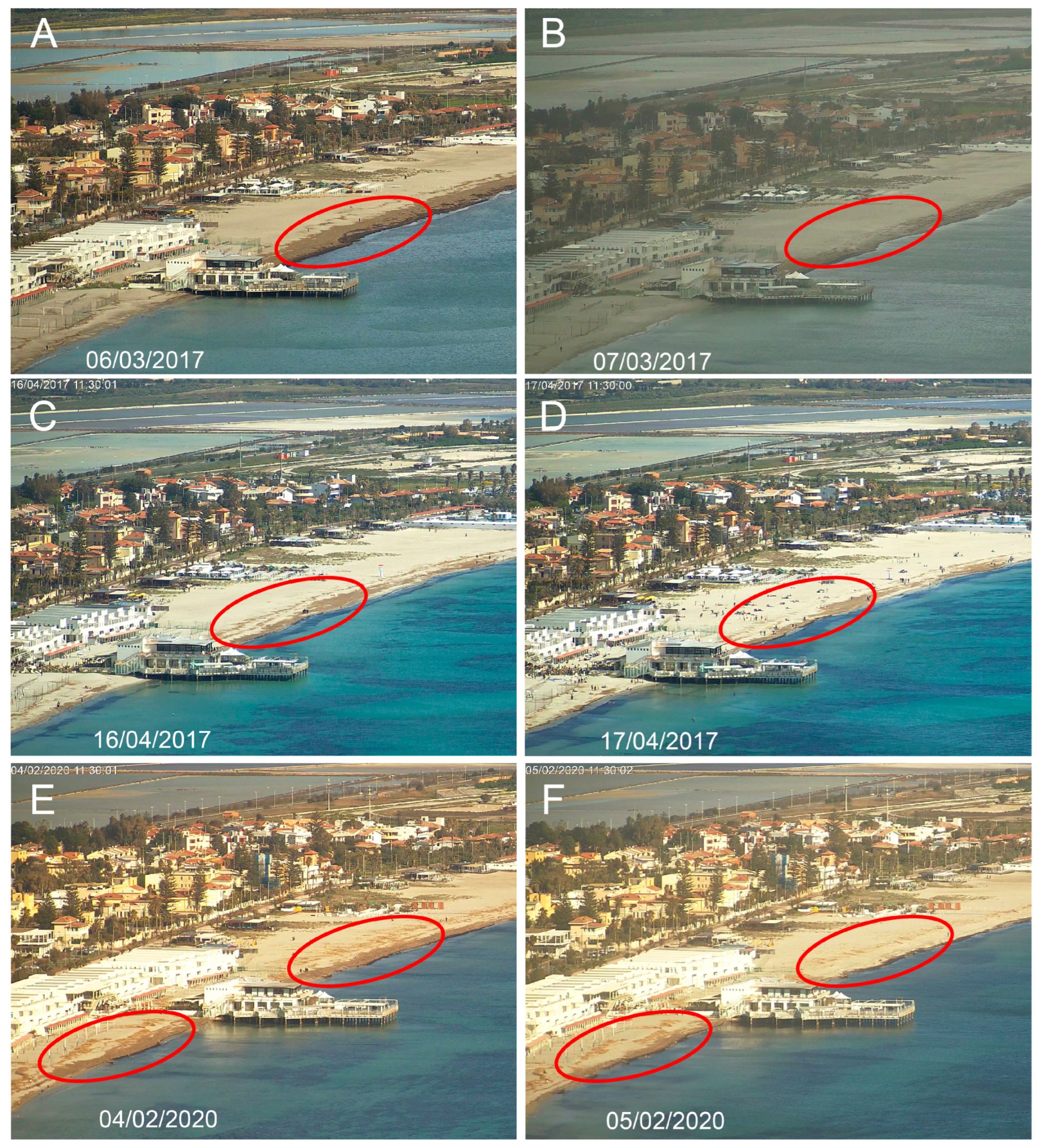
| T1 (206 days) | T2 (253 days) | T3 (266 days) | |
|---|---|---|---|
| Mean extension | 6.3 m | 7.5 m | 7.7 m |
| Max. extension | 17.5 m | 21.5 m | 27.9 m |
| Min. extension | 0.4 m | 0.3 m | 0.3 m |
| St. deviation | 4.3 m | 4.8 m | 5.3 m |
| T1 | T2 | T3 | |
|---|---|---|---|
| Hs mean deposition | 0.6 m | 0.7 m | 0.7 m |
| Hs mean erosion | 1.1 m | 1.0 m | 0.9 m |
| Tp mean deposition | 7.5 s | 8.1 s | 8.1 s |
| Tp mean erosion | 8.0 s | 7.2 s | 6.8 s |
| Tm mean deposition | 4.3 s | 4.9 s | 4.5 s |
| Tm mean erosion | 4.6 s | 4.2 s | 3.4 s |
| n° events deposition | 27 | 37 | 46 |
| n° events erosion | 17 | 28 | 39 |
| Energy flux mean deposition | 19,336 W (m2)−1 | 24,008 W (m2)−1 | 24,228 W (m2)−1 |
| Energy flux mean erosion | 90,302 W (m2)−1 | 53,542 W (m2)−1 | 42,098 W (m2)−1 |
| Events with Retreat/Erosion ≥ 4 m | T1 | T2 | T3 |
|---|---|---|---|
| Hs mean erosion | 1.1 m | 1.1 m | 1.0 m |
| Tp mean erosion | 8.3 s | 7.7 s | 7.6 s |
| Tm mean erosion | 4.8 s | 4.4 s | 4.6 s |
| n° events erosion | 17 | 28 | 39 |
| n° events erosion with waves | 15 (88.2%) | 24 (85.7%) | 28 (71.8%) |
| Energy flux mean erosion | 103,011 W (m2)−1 | 60,280 W (m2)−1 | 54,123 W (m2)−1 |
| Events with Retreat/Erosion ≥ 4 m | T1 | T2 | T3 |
|---|---|---|---|
| Total number of retreat events | 17 | 28 | 39 |
| Total mean wind speed (Km h−1) during all the retreat events | 33.8 (n = 17) | 31.2 (n = 28) | 32.8 (n = 39) |
| n° retreat events with offshore winds and their proportion to total retreat events | 2 (11.8%) | 4 (14.2%) | 11 (28.2%) |
| Mean wind speed (Km h−1) during retreat events with offshore winds | 45.2 (n = 2) | 48.2 (n = 4) | 42.15 (n = 11) |
Disclaimer/Publisher’s Note: The statements, opinions and data contained in all publications are solely those of the individual author(s) and contributor(s) and not of MDPI and/or the editor(s). MDPI and/or the editor(s) disclaim responsibility for any injury to people or property resulting from any ideas, methods, instructions or products referred to in the content. |
© 2023 by the authors. Licensee MDPI, Basel, Switzerland. This article is an open access article distributed under the terms and conditions of the Creative Commons Attribution (CC BY) license (https://creativecommons.org/licenses/by/4.0/).
Share and Cite
Trogu, D.; Simeone, S.; Ruju, A.; Porta, M.; Ibba, A.; DeMuro, S. A Four-Year Video Monitoring Analysis of the Posidonia oceanica Banquette Dynamic: A Case Study from an Urban Microtidal Mediterranean Beach (Poetto Beach, Southern Sardinia, Italy). J. Mar. Sci. Eng. 2023, 11, 2376. https://doi.org/10.3390/jmse11122376
Trogu D, Simeone S, Ruju A, Porta M, Ibba A, DeMuro S. A Four-Year Video Monitoring Analysis of the Posidonia oceanica Banquette Dynamic: A Case Study from an Urban Microtidal Mediterranean Beach (Poetto Beach, Southern Sardinia, Italy). Journal of Marine Science and Engineering. 2023; 11(12):2376. https://doi.org/10.3390/jmse11122376
Chicago/Turabian StyleTrogu, Daniele, Simone Simeone, Andrea Ruju, Marco Porta, Angelo Ibba, and Sandro DeMuro. 2023. "A Four-Year Video Monitoring Analysis of the Posidonia oceanica Banquette Dynamic: A Case Study from an Urban Microtidal Mediterranean Beach (Poetto Beach, Southern Sardinia, Italy)" Journal of Marine Science and Engineering 11, no. 12: 2376. https://doi.org/10.3390/jmse11122376
APA StyleTrogu, D., Simeone, S., Ruju, A., Porta, M., Ibba, A., & DeMuro, S. (2023). A Four-Year Video Monitoring Analysis of the Posidonia oceanica Banquette Dynamic: A Case Study from an Urban Microtidal Mediterranean Beach (Poetto Beach, Southern Sardinia, Italy). Journal of Marine Science and Engineering, 11(12), 2376. https://doi.org/10.3390/jmse11122376








